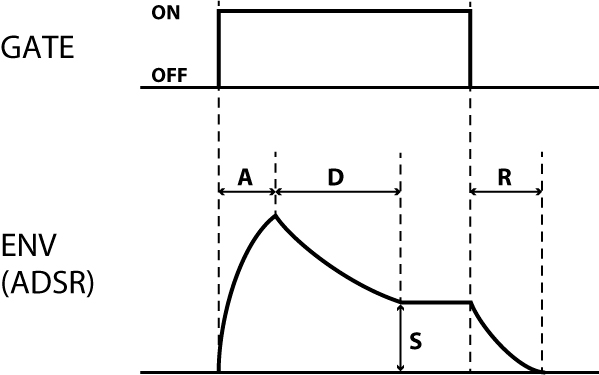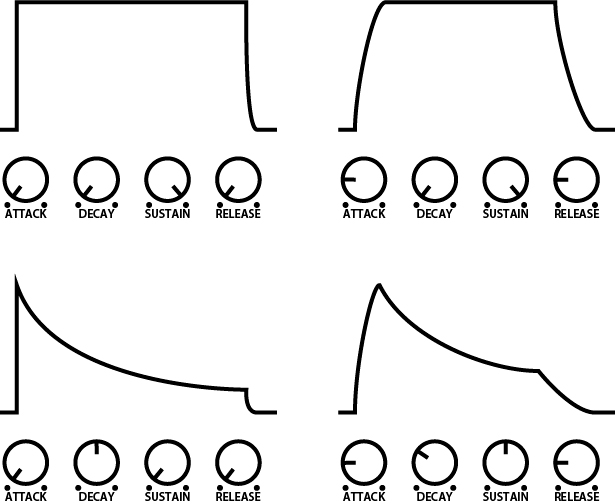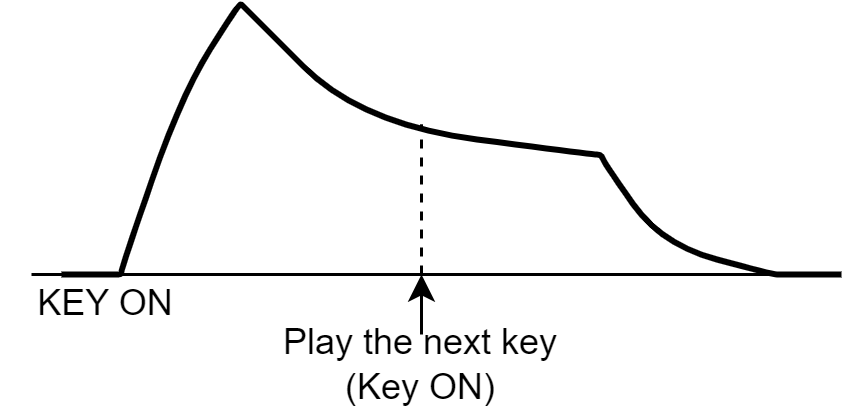This section creates control signals to make time-based changes to the sound.
These signals are generated when you play the keyboard pads. The signals control the FILTER and AMP sections to change the sound and volume of each note you play over time.
[ATTACK] knob (A)
This knob sets the time (attack time) it takes for the control signal to reach its peak level after you press a keyboard pad.
[DECAY] knob (D)
This knob sets the time (decay time) it takes for the control signal to reach the sustain level after reaching its peak level.
The decay time is closely related to the sustain level. When you adjust the [DECAY] knob while the sustain is set to the highest level, the envelope shape doesn’t change.
[SUSTAIN] knob (S)
This knob sets the sustain level, which is the level that the sound stays at after the envelope reaches its peak.
The level is held as long as you hold down the keyboard pad.
[RELEASE] knob (R)
This knob sets the time (release time) it takes for the control signal to drop to zero (where the envelope reaches its end) after you release the keyboard pad.

ADSR settings and envelope waveforms

Selecting the signal used to control the envelope (ENV TRG: envelope trigger)
Follow these steps to select which signal is used for controlling the envelope generator.
- Hold down the [SHIFT] button and press the [ENV TRG] pad.
Turn the [TEMPO/VALUE] knob to edit the value.
Value
Explanation
LFO LFO
The envelope generator operates repeatedly, following the LFO rate (cycle) of the modulator.
With this setting, the envelope repeats its attack phase while you’re holding down a keyboard pad, and the envelope stops when you release the pad.
Each time you play a keyboard pad again (after completely taking your finger off a pad and then playing the next pad), the envelope always returns to the beginning (attack phase), regardless of what’s going on with the LFO.
GAtE GATE
When in POLY mode, if you’ve selected a mode besides “PoLy”, the envelope goes to its attack phase each time you play a keyboard pad (completely taking your finger off a pad and then playing the next pad).
If you want to make tonal or time-based changes to each note, you must play in a non-legato style.
If “PoLy” is selected while the unit is in POLY mode, time-based changes are applied to the volume or tonal quality of each note you play, regardless of whether you play in a legato or non-legato style.
triG GATE+TRIG
If you play a keyboard pad while holding down a different keyboard pad, the envelope is retriggered for the new note you played.
In other words, this lets you make tonal or time-based changes to each note you play, regardless of whether you play in a legato or non-legato style.

When “Nono”, “Uni”, or “Chd” are selected in POLY mode
If this unit is in POLY mode and you select “ Nono”, “ Uni”, “ Chd” for inputting single notes, the unit behaves as shown below when you input more than one note.When ENV TRG is LFO or GATE
You can use the Note Priority setting (“n.Pri” in the menu) to select between giving priority to either the last note (LASt) or the lowest note (Loľ) that you play.
When ENV TRG is GATE+TRIG
The unit gives priority to the last note you played, meaning that whichever keyboard pad you played last is always given priority.